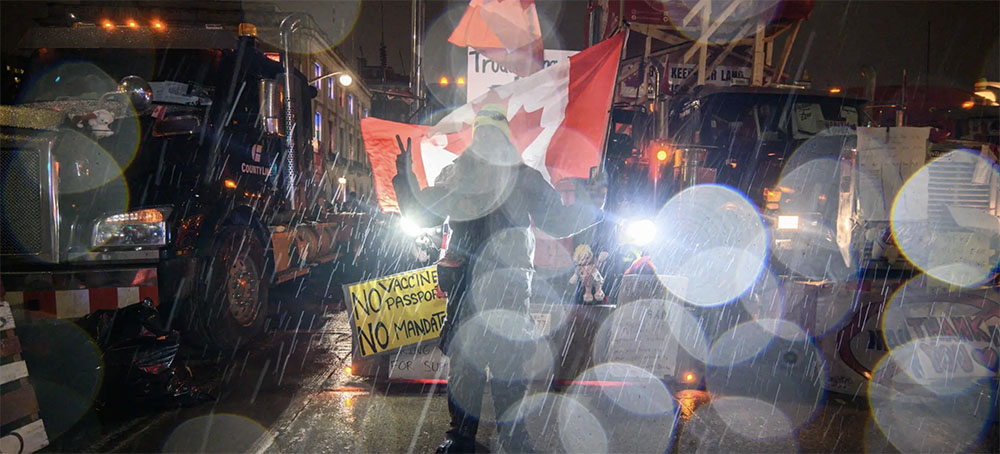When 'Freedom' Means the Right to Destroy
Paul Krugman The New York Times The Canadian trucker convoy. (photo: Ed Jones/AFP/Getty Images)
15 February 22
The Canadian trucker convoy. (photo: Ed Jones/AFP/Getty Images)
15 February 22
The mistrust of the Canadian authorities in the face of these disturbances surprised the Americans. Also surprising, though not really surprising, has been the embrace of economic vandalism and bullying by much of the American right – especially by people who have spoken out against the racial justice protests. What we get here is an object lesson in what some people really mean when they talk about “law and order.”
Let’s talk about what happened in Canada and why I call it vandalism.
The “Freedom Convoy” has been marketed as a backlash by truckers angry at Covid-19 vaccination mandates. In reality, there did not appear to have been many truckers among the protesters at the bridge (about 90% of Canadian truckers are vaccinated). Last week, a Bloomberg reporter saw just three tractor-trailers among the vehicles blocking the Ambassador Bridge, which were mostly pickup trucks and private cars; photos taken on Saturday also show very few commercial trucks.
The Teamsters union, which represents many truckers on both sides of the border, denounced the blockade.
It is therefore not a popular uprising of truckers. It’s more like a slow-motion January 6, a disruption caused by a relatively small number of activists, many of whom are right-wing extremists. At their peak, the protests in Ottawa were said to have involved only around 8,000 people, while numbers in other places were much lower.
Despite their lack of numbers, however, the protesters have inflicted a remarkable amount of economic damage. The American and Canadian economies are very closely integrated. In particular, North American manufacturing, especially but not only in the automotive industry, relies on a constant flow of parts between factories on both sides of the border. As a result, disruption of this flow has hampered the industry, forcing production cuts and even plant closures.
The closure of the Ambassador Bridge also imposed significant overhead costs, as trucks were diverted to roundabout roads and forced to wait in long lines at alternate bridges.
Any attempt to quantify the economic costs of the blockade is delicate and speculative. However, it’s not hard to come up with numbers like $300 million or more per day; combine that with the disruption in Ottawa, and the “trucker” protests may have already inflicted a few billion dollars in economic damage.
It’s an interesting figure, as it’s roughly comparable to insurance industry estimates of total losses associated with the Black Lives Matter protests that followed the murder of George Floyd – protests that appear to have involved more than 15 million people. people.
This comparison will no doubt surprise those who inquire about the right-wing media, which portrays BLM as an orgy of arson and looting. I still get mail from people who believe that much of New York has been reduced to smoking rubble. In fact, the protests were remarkably non-violent; vandalism occurred in a few cases, but it was relatively rare and damage was minimal considering the scale of the protests.
By contrast, causing economic damage was and is the goal of the Canadian protests — because blocking essential flows of goods, threatening people’s livelihoods, is just as destructive as smashing a store window. And unlike, say, a company-specific strike, that damage fell indiscriminately on anyone who had the misfortune to rely on unimpeded trade.
And to what end? The BLM protests were a reaction to police killings of innocent people; what is happening in Canada is, on its face, a rejection of public health measures intended to save lives. Of course, even that is just an excuse: it is actually an attempt to exploit pandemic fatigue to spur the usual culture war agenda.
As you’d expect, the American right loves it. People who have described peaceful protests against police killings as an existential threat are thrilled by the sight of right-wing activists breaking the law and destroying wealth. TBEN News has devoted many hours to flattering coverage of the lockdowns and occupations. Senator Rand Paul, who called BLM activists a ‘crazy mob’, called for Canadian-style protests to ‘clog cities’ across the US, specifically saying he hoped to see truckers disrupt the Super Bowl (They did not do it).
I guess the reopening of the Ambassador Bridge is the start of a broader crackdown on destructive protests. But I hope we won’t forget this moment – and especially remember it the next time a politician or media personality talks about “law and order”.
Recent events have confirmed what many suspected: the right is all for, even enthusiastic about illegal actions and disorder as long as they serve right-wing goals.
The article When ‘Freedom’ Means the Right to Destroy appeared first on the New York Times.



